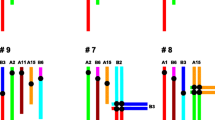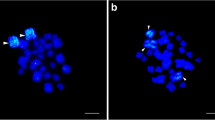Abstract
Reciprocal translocations occur in high frequencies in Clarkia speciosa and closely related species. Observations from C. speciosa suggest this species is predisposed to translocations involving breaks in or adjacent to the centrochromatin (centromeric chromatin) due to the characteristic association of all nonhomologous centrochromatin in the genome during early meiotic prophase. Translocation heterozygote multiples involving six different breaks were examined for homologous pairing and in each case the euchromatic arms were completely paired, the change in homologous pairing occuring within the nonhomologous centrochromatic association. Such a proximal exchange point precludes the possibility of a structurally determined interstitial or differential region and, therefore, any genetically differential regions that might exist must be maintained solely by means of distal localization of crossing over. — The frequency of chromosomal nondisjunction (adjacent segregation) was found to be positively correlated with the number of chromosomes in the translocation multiple. Rings of four chromosomes had an average disjunction of over 99% and therefore had little affect on fertility whereas the largest multiples of 16 chromosomes had an average disjunction of about 10% and correspondingly low fertility.
Similar content being viewed by others
References
Barr, H. J., Ellison, J. R.: Ectopic pairing of chromosome regions containing chemically similar DNA. Chromosoma (Berl.) 39, 53–61 (1972)
Barton, D. W.: Localized chiasmata in the differentiated chromosomes of the tomato. Genetics 36, 374–381 (1951)
Bloom, W. L.: The effect of chromosomal translocations on genetic recombination within and between populations of Clarkia speciosa (Lewis and Lewis). Ph.D. Thesis, Univ. of Calif., Los Angeles, Library, U.S.A. (1970)
Bloom, W., Lewis, H.: Interchanges and interpopulational gene exchange in Clarkia speciosa. Chromosomes today, 3, 268–284 (1972)
Brinkley, B. R., Stubblefield, E.: Ultrastructure and interaction of the kinetochore and centriole in mitosis and meiosis. Advanc. Cell Biol. 1, 119–185 (1970)
Burnham, C. R., Stout, J. T., Weinheimer, W. H., Knowles, R. V., Phillips, R. L.: Chromosomal pairing in maize. Genetics 71, 111–126 (1972)
Cleland, R. E.: Oenothera: cytogenetics and evolution. London: Academic Press Inc. 1972
Comings, D. E.: The structure and function of chromatin. Advanc. human Genet. 3, 237–394 (1972)
Cuevas-Sosa, A.: Crossing over and the centromere. Cytogenetics 6, 331–341 (1967)
Darlington, C. D.: Recent advances in cytology, 2nd edit. London: Churchill 1937
Darlington, C. D.: Prime variables of meiosis. Biol. Rev. 15, 307–322 (1940)
DuPraw, E. J.: Cell and molecular biology. New York: Academic Press Inc. 1968
Evans, H. J., Bigger, T. R. L.: Chromatid aberrations induced by gamma irradiation. II. Nonrandomness in the distribution of chromatid aberrations in relation to chromosome length in Vicia faba root-tip cells. Genetics 46, 277–289 (1961)
Gottschalk, W.: Untersuchungen am Pachytän normaler and röntgenbestrahlter Pollenmutterzellen von Solanum lycopersicum. Chromosoma (Berl.) 4, 298–341 (1951)
Henderson, S. A.: The salivary gland chromosomes of Dasyneura crataegi (Diptera: Cecidomyiidae). Chromosoma (Berl.) 23, 38–58 (1967)
John, B., Hewitt, G. M.: Patterns and pathways of chromosome evolution within the Orthoptera. Chromosoma (Berl.) 25, 40–74 (1968)
John, B., Hewitt, G. M.: Inter-population sex chromosome polymorphism in the grasshopper Podisma pedestris. I. Fundamental facts. Chromosoma (Berl.) 31, 291–308 (1970)
John, B., Lewis, K. R.: Studies on Periplaneta americana. III. Selection for heterozygosity. Herdity 12, 185–197 (1958)
John, B., Lewis, K. R.: The meiotic system. Protoplasmatologia, VI/F 1 Wien: Springer 1965
Jones, K.: Telocentric chromosomes in plants. Chromosomes today 2, 218–222 (1969)
Kato, H., Sagai, T., Yosida, T. H.: Stable telocentric chromosomes produced by centric fission in chinese hamster cells in vitro. Chromosoma (Berl.) 40, 183–192 (1973)
Kezer, J., MacGregor, H. C.: A fresh look at meiosis and centromeric heterochromatin in the Red-backed Salamander, Plethodon cinereus cinereus (Green). Chromosoma (Berl.) 33, 146–166 (1971)
Khush, G. S., Rick, C. M.: Cytogenetic analysis of the tomato genome by means of induced deficiencies. Chromosoma (Berl.) 23, 452–484 (1968)
Kihlman, B. A.: Actions of chemicals on dividing cells. Englewood Cliffs, N. J.: Prentice-Hall 1966
Lea, D. E.: Actions of radiations on living cells, 2nd edit. Cambridge: University Press 1955
Lewis, H., Lewis, M. E.: The genus Clarkia. Univ. Calif. Publ. Botany 20, 241–392 (1955)
Lima-de-Faria, A.: Recent advances in the study of the kinetochore. Int. Rev. Cytol., 7, 123–157 (1958)
Luykx, P.: Cellular mechanisms of chromosome distribution. Int. Rev. Cytol., Suppl. 2, (1970)
Maguire, M. P.: The temporal sequence of synaptic initiation, crossing over and synaptic completion. Genetics 70, 353–370 (1972)
Matsuura, H., Kurabayashi, M.: Chromosome studies on Trillium kamtschaticum Pall. and its allies. XXIV. The association of kinetochores of non-homologous chromosomes at meiosis. Chromosoma (Berl.) 4, 273–283 (1951)
McClintock, Barbara: The association of non-homologous parts of chromosomes in the mid-prophase of meiosis in Zea mays. Z. Zellforsch. 19, 191–237 (1933)
Mosquin, T., Lewis, H.: Variation in relation to reciprocal translations in a diploid species of Clarkia (Onagraceae). Proc. IX Int. Bot. Congr. 2, 272 (1959)
Natarajan, A. T., Ahnström, G.: Heterochromatin and chromosome aberrations. Chromosoma (Berl.) 28, 48–61 (1969)
Schmid, W.: Heterochromatin in mammals. Arch. Klaus-Stift. Vererb.-Forsch. 42, 1–59 (1967)
Shaw, D. D.: Pseudomultiple production in Ageneotettix deorum deorum. Chromosoma (Berl.) 31, 421–433 (1970)
Snow, R., Dunford, M. P.: A study of interchange heterozygosity in a population of Datura meteloides. Genetics 46, 1097–1110 (1961)
Southern, D. I.: Stable telocentric chromosomes produced following centric misdivision in Myrmeleotettix maculatus (Thunb.) Chromosoma (Berl.) 26, 140–147 (1969)
White, M. J. D.: Animal cytology and evolution, 2nd edit. Cambridge: University Press 1954
White, M. J. D.: Chromosomal rearrangements and speciation in animals. Ann. Rev. Genet. 3, 75–98 (1969)
Whittingham, A. D., Stebbins, G. L.: Chromosomal rearrangements in Plantago insularis Eastw. Chromosoma (Berl.) 26, 449–468 (1969)
Yunis, J. J., Yasmineh, W. G.: Heteroehromatin, satellite DNA, and cell function. Science 174, 1200–1209 (1970)
Author information
Authors and Affiliations
Rights and permissions
About this article
Cite this article
Bloom, W.L. Origin of reciprocal translocations and their effect in Clarkia speciosa . Chromosoma 49, 61–76 (1974). https://doi.org/10.1007/BF00284988
Received:
Issue Date:
DOI: https://doi.org/10.1007/BF00284988




